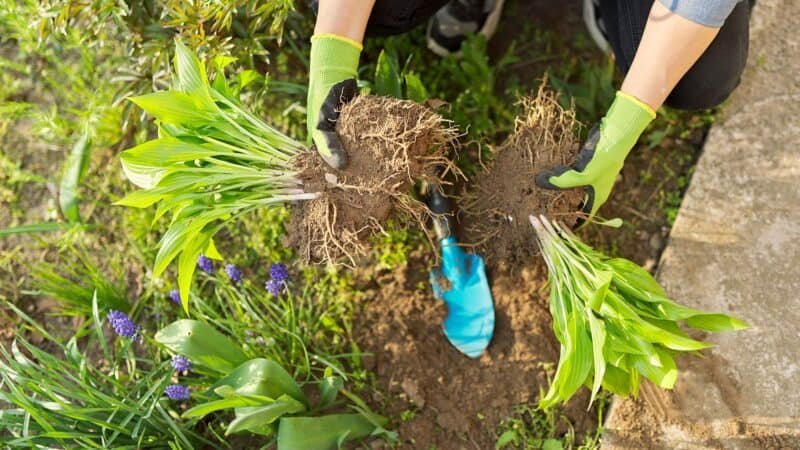Hostas are commonly grown as shade plants and are easy to divide. Successfullyidentifying when to divide hostas allows them to thrive in your garden. Choosing late summer or the window from spring to fall is ideal for this exercise.
Dividing this plant enables you to maintain their size, remove dead portions, and propagate new shoots for vacant garden patches. The division technique proves to be more fruitful than cultivating hosta plants from seeds.

Time it Right
When you notice your hostas getting too crowded and the clump’s center thinning out, it indicates division time. Dividing fast-growing hosta varieties every two years or so keeps them at their healthiest. To perform this exercise, pick either the growing season’s start or nearing its end.
The presence of cooler daytime temperatures ensures the soil retains moisture and the plants demand less water. This allows their root system to hold the ground firmly, and your hostas thrive before the summer heat or the winter chill kicks in.
You can split the plants in early spring when their leaves begin to come out from the soil. Digging them up for division a few weeks short of the first frost, which is early fall, is also advisable. Only then, your plants get time to take root before the ground freezes. These guidelines should clear your doubts about when to divide hostas.
Divide with Care
Hosta roots grow from their tips, so keeping them intact while undertaking the division is critical. Listed here are some essential aspects to bear in mind:
- Water the soil well a day before the split to make it easier to dig out the plants.
- Hold your digging fork at an angle and gently scoop out the plant from the soil.
- Use your fingers to dislodge the soil and untangle roots.
- To minimize damage to the root system, identify natural breaks from where you can easily divide the hostas.
- Remove damaged leaves or those without connecting roots.
- Preferably transplant all the new divisions immediately, so they are not deprived of nourishment.
Transplanting Guidelines
Since hostas love moisture, you must plant your divisions in shady spots that receive low levels of sunlight. Identifying the appropriate location ensures their survival. In addition, maintaining proper spacing and correct depth is also essential.
Dwarf hostas do well with 6 to 8 inches of depth and spacing, while small varieties need 12 to 18 inches. For medium plants, stick to the 18 to 24-inch policy while conforming to 30 to 36 inches in the case of large varieties.
The new hole should be twice the plant’s width and slightly deeper than its roots. Support this popular garden plant by mounding a little soil on its base. Gently spread out the roots, refill the opening with the soil initially dugout, and pat it down in place. On filling the hole, add water to the soil to remove air pockets.
Hostas thrive in humid climates and demand frequent watering. Pruning or cutting away overgrown and dead plant matter from their roots allows your hostas to flourish. In the end, ensure you discard all unwanted scraps.
Learn more about this hosta dividing practice from seasoned gardening experts who share valuable resources.




